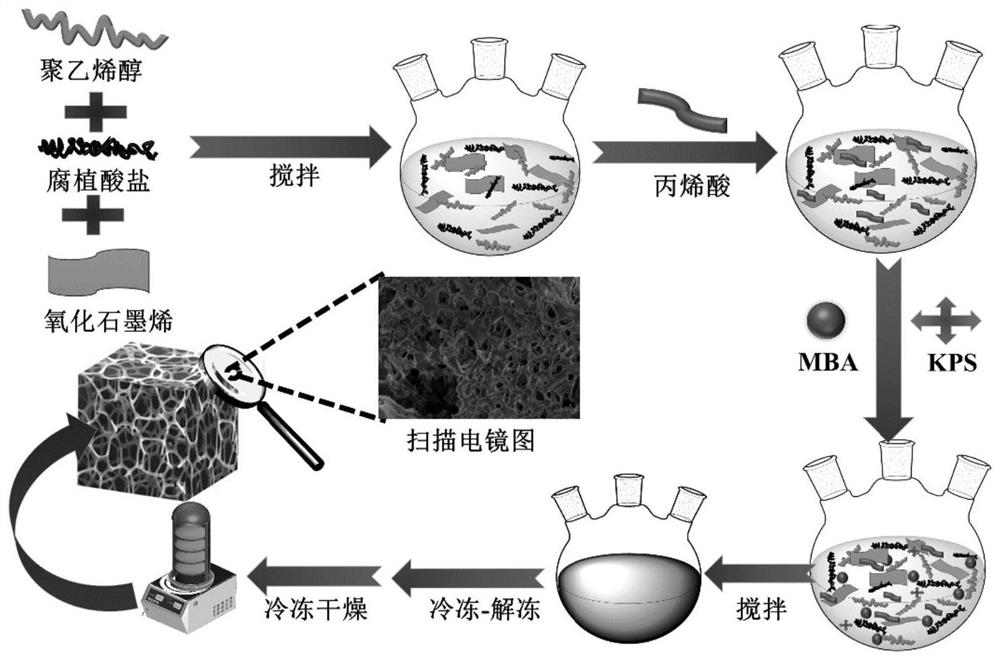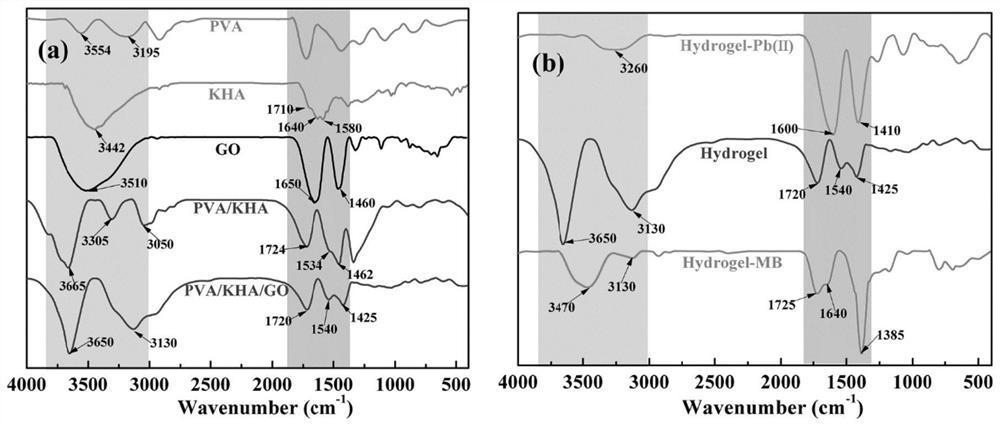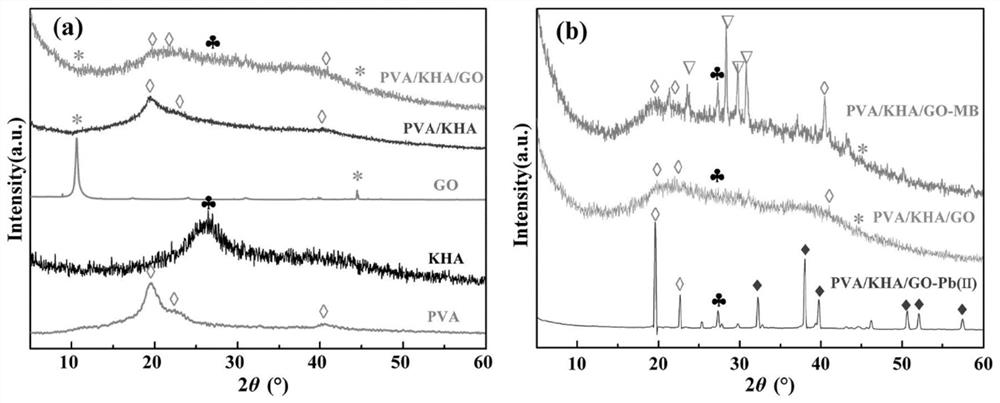Graphene oxide type adsorption material and preparation method and application thereof
An adsorption material, graphene technology, applied in the field of material preparation and environmental science, can solve the problems of non-reusable, poor selectivity, high technical requirements and high cost of synthesis process
- Summary
- Abstract
- Description
- Claims
- Application Information
AI Technical Summary
Problems solved by technology
Method used
Image
Examples
Embodiment 1
[0050] Mix 10g of 6% polyvinyl alcohol solution, 10g of 0.1% sodium humate solution and 6g of 0.5% graphene oxide aqueous dispersion solution at 50°C under stirring at a rotation speed of 100r / min to form a mixed solution A. Then, 10 g of 0.2% N,N'-methylenebisacrylamide solution was added to 10 g of 20% acrylic acid solution to form a mixed solution B, which was dropped into the mixed solution A at a rate of 3 drops / s. At the same time, 10 g of 0.4% ammonium persulfate solution was dropped into the mixed solution A at a rate of 2 drops / s. After the above solution was added dropwise and the mechanical stirring was continued for 20 min, the temperature was raised to 70° C., and the stirring was continued for 2 h to obtain a viscous gel material. The gel material was frozen at -4°C for 6 hours, then thawed at room temperature for 6 hours, freeze-thawed three times under the same conditions and operations, and then placed in a freeze dryer to freeze-dry to obtain a graphene oxide...
Embodiment 2
[0052] Mix 15g of 8% polyvinyl alcohol solution, 10g of 0.8% potassium humate solution and 8g of 0.8% graphene oxide aqueous dispersion solution at 55°C under stirring at a rotation speed of 120r / min to form a mixed solution A. Then add 10 g of 0.3% N,N'-methylenebisacrylamide solution into 10 g of acrylic acid solution with a neutralization degree of 40%, to form a mixed solution B, which is dropped into the mixed solution A at a rate of 4 drops / s. At the same time, 10 g of 0.7% potassium persulfate solution was dropped into the mixed solution A at a rate of 3 drops / s. After the dropwise addition of the above solution was completed, the mechanical stirring was continued for 30 minutes, and then the temperature was raised to 70° C., and the stirring was continued for 3 hours to obtain a viscous gel material. The gel material was frozen at -4°C for 8 hours, then thawed at room temperature for 8 hours, frozen and thawed four times under the same conditions and operations, and th...
Embodiment 3
[0054] Mix 20g of 6% polyvinyl alcohol solution, 10g of 1.5% potassium humate solution and 10g of 1% graphene oxide water dispersion solution at 60°C and stir at a speed of 140r / min to form a mixed solution A. Then add 10g of 0.5% N,N'-methylenebisacrylamide solution into 10g of acrylic acid solution with a neutralization degree of 60% to form a mixed solution B, which is dropped into the mixed solution A at a rate of 5 drops / s. At the same time, 10 g of 1.0% ammonium persulfate solution was dropped into the mixed solution A at a rate of 4 drops / s. After the above solution was added dropwise, the mechanical stirring continued for 40 minutes, and then the temperature was raised to 70° C., and the stirring was continued for 4 hours to obtain a viscous gel material. The gel material was frozen at -4°C for 10 hours, then thawed at room temperature for 10 hours, frozen and thawed 5 times under the same conditions and operations, and then placed in a freeze dryer to freeze-dry to ob...
PUM
| Property | Measurement | Unit |
|---|---|---|
| specific surface area | aaaaa | aaaaa |
| pore size | aaaaa | aaaaa |
Abstract
Description
Claims
Application Information
 Login to View More
Login to View More - R&D
- Intellectual Property
- Life Sciences
- Materials
- Tech Scout
- Unparalleled Data Quality
- Higher Quality Content
- 60% Fewer Hallucinations
Browse by: Latest US Patents, China's latest patents, Technical Efficacy Thesaurus, Application Domain, Technology Topic, Popular Technical Reports.
© 2025 PatSnap. All rights reserved.Legal|Privacy policy|Modern Slavery Act Transparency Statement|Sitemap|About US| Contact US: help@patsnap.com



